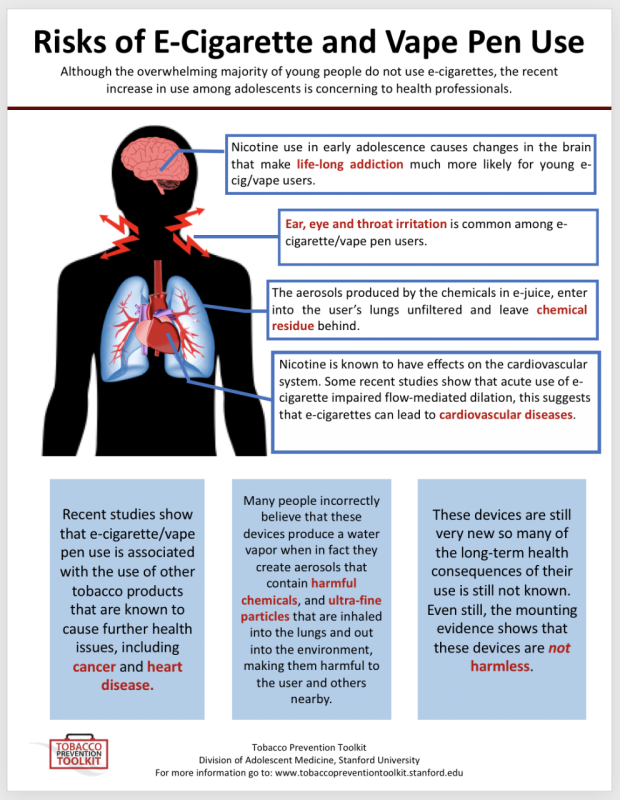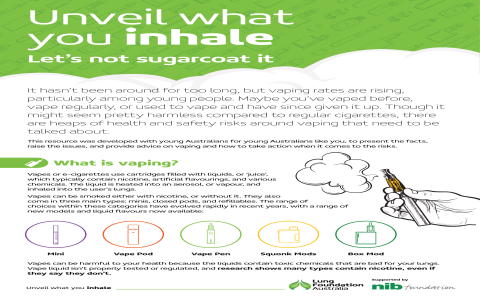The Composition and Lung Risks
E-cigarettes (e-cigs) heat a liquid (e-liquid or vape juice) containing nicotine, flavorings, propylene glycol (PG), and vegetable glycerin (VG) to create an aerosol inhaled into the lungs. Key lung concerns include:
- Inhalation of Ultrafine Particles: The aerosol contains fine and ultrafine particles capable of penetrating deep into lung tissue. These can cause inflammation and irritation.
- Flavoring Chemicals: Many flavoring agents, particularly diacetyl (linked to “popcorn lung” or bronchiolitis obliterans), cinnemaldehyde, and others, are safe to ingest but harmful when inhaled, causing direct irritation and potential cell damage.
- Nicotine: While primarily addictive, nicotine itself constricts airways and can impair lung function development in adolescents.
- Formaldehyde and Acrolein: Under high-temperature conditions (“dry puffing”), e-liquids can degrade, forming toxic aldehydes like formaldehyde and acrolein, known lung irritants and carcinogens.
- EVALI (E-cigarette, or Vaping, product use-Associated Lung Injury): Linked strongly to additives like Vitamin E Acetate in illicit THC cartridges, EVALI causes severe, sometimes fatal, lung damage (lipoid pneumonia). While less common now, the risk with unregulated products remains.
Comparing Harm: E-cigs vs. Traditional Cigarettes
While e-cigs generally expose users to fewer toxicants and carcinogens than combustible cigarettes, this does not equate to being safe:

- Lower Risk ≠ No Risk: Cigarette smoke contains >7,000 chemicals, many carcinogenic (like tar and carbon monoxide). E-cig aerosols contain fewer quantities of these, but many chemicals are still present or unique to vaping.
- Dual Use is Prevalent and Dangerous: Many users (especially youth) use both products, exposing their lungs to harms from both sources.
Potential Benefits and Controversies
Healthcare professionals sometimes note a potential benefit:
- Harm Reduction for Current Smokers: For adult smokers unable or unwilling to quit using FDA-approved methods, completely switching to regulated e-cigs might be a less harmful alternative to continued smoking. The key is complete switching, not dual use.
The Critical Unknown: Long-Term Effects
The most significant gap in knowledge is the long-term impact of e-cig use on lung health over decades.
- Long-term combustible cigarette smoking causes COPD and lung cancer – diseases that develop over many years. E-cigs haven’t existed long enough for us to definitively know their long-term lung disease profile.
- Growing evidence suggests links to chronic lung diseases like asthma exacerbation, chronic bronchitis symptoms (“vaper’s cough”), and potentially early signs of emphysema development.
Key Takeaways for Lung Health
- Not Safe, Especially for Youth & Non-smokers: E-cig use poses significant and avoidable risks to lung health. Non-smokers, particularly adolescents and young adults, should never start.
- EVALI Risk: Avoid all vaping products from informal sources (friends, online dealers, illicit market).
- Chemical Exposure: Inhaling flavored aerosols delivers a mix of chemicals known to cause lung inflammation, irritation, and potential cell damage.
- Long-Term Uncertainty: The full spectrum of long-term lung diseases potentially caused by years of vaping is not yet known and remains a major concern.
- Cessation is Best: For smokers, the most effective way to protect lung health is to quit nicotine entirely using FDA-approved therapies (counseling, patches, gum, lozenges, prescription meds like varenicline or bupropion).
Conclusion: Current scientific evidence confirms that e-cigarettes are harmful to lung health. While potentially less harmful than smoking for current adult smokers who completely switch, they are not a safe alternative to breathing clean air. For lung health, avoiding all inhaled nicotine products is the best course of action.








